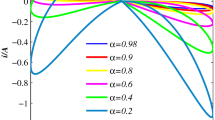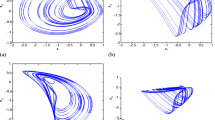Abstract
In this paper, a fractional-order locally active memristor is proposed based on the definition of fractional derivative. It is found that the side lobe area of the pinched hysteretic curve of the memristor changes with the fractional-order value, and the side lobe’s area of the fractional-order memristor is greater than that of the memristor with integer order, meaning that the memory of the fractional-order memristor is stronger than that of the memristor with integer order. It is proved by the dynamic rout map (DRM) that the fractional-order memristor possesses continuous memory. The pinched hysteresis, memristance and power characteristics which vary with the fractional order are compared and analysed in detail. Furthermore, we use the memristor to construct a fractional-order chaotic circuit, which can exhibit continuous chaotic motion in the range of \(0.75<\) fractional order \(\alpha < 1\) and various coexisting attractors. We also show that the lower fractional order causes higher complexity of the fractional-order chaotic system using different methods, such as Lyapunov exponent spectrum, bifurcation diagram, spectral entropy and C0 complexity method. Finally, the circuit simulations of the fractional-order chaotic circuit are realised, demonstrating the validity of the mathematical model and the theoretical analysis.
























Similar content being viewed by others
References
L O Chua, IEEE Trans. Circuit Theory 18, 507 (1971)
D B Strukov, G S Snider, D R Stewart and R S Williams, Nature 453, 80 (2008)
Y J Yu and Z H Wang, Int. J. Bifurc. Chaos 28, 1850091 (2018)
H B Bao and J D Cao, Neural Netw. 1, 63 (2015)
J T Machado, Commun. Nonlin. Sci. Numer. Simulat. 264, 18 (2013)
D Y Xue and C N Zhao, Control Theory Appl. 24, 771 (2007)
Y J Yu and Z H Wang, Acta Phys. Sin. 64, 238401 (2015)
I Petráás̆ and Y Q Chen, IEEE International Carpathian Control Conference (2012)
M E Fouda and A G Radwan, J. Fract. Calc. Appl. 4, 1 (2017)
M E Fouda and A G Radwan, Circuits Syst. Signal Process 34, 961 (2015)
E M Hamed, M E Fouda and A G Radwan, IEEE International Symposium on Circuits and Systems (2018)
A H Elsafty, E M Hamed, M E Fouda, L A Said and A H Madian, 7th International Conference on Modern Circuits and Systems Technologies (MOCAST) (2018)
J Wu, G Y Wang, H H C Iu, Y R Shen and W Zhou, Entropy 21, 955 (2019)
D Cafagna and G Grassi, Int. J. Bifurc. Chaos 18, 615 (2008)
I Grigorenko and E Grigorenko, Phys. Rev. Lett. 91, 34101 (2003)
V T Pham, S T Kingni, C Volos, S Jafari and T Kapitaniak, Int. J. Electron. Commun. 78, 220 (2017)
Y Xu, H Wang, Y Li and B Pei, Commun. Nonlin. Sci Numer. Simulat. 19, 3735 (2014)
P Muthukumar, P Balasubramaniam and K Ratnavelu, Nonlinear Dyn. 80, 1883 (2015)
D Cafagna and G Grassi, Nonlinear Dyn. 70, 1185 (2012)
I Petrás̆, IEEE Trans. Circuits Syst. II: Express Br. 57, 975 (2010)
N N Yang, C Xu, C J Wu and R Jia, Int. J. Bifurc. Chaos 27, 1750199 (2017)
L O Chua, Int. J. Bifurc. Chaos 15, 3435 (2005)
L O Chua, Semicond. Sci. Technol. 29, 104001 (2014)
S P Adhikari, M P Sah, H Kim and L O Chua, IEEE Trans. Circuits Syst. I: Regul. Pap. 60, 3008 (2013)
M D Pickett and R S Williams, Nanotechno l. 23, 215202 (2012)
S Kumar, J P Strachan and R S Williams, Nature 548, 318 (2017)
B R Xu, G Y Wang, X Y Wang and H H C Iu, Pramana – J. Phys. 93, 1 (2019)
K H Sun, Principle and technology of chaotic secure communication (Tsinghua University Press, Beijing, 2015)
N Heymans and I Podlubny, Rheol. Acta 45, 5 (2006)
R Agarwal, S Hristova and D O Regan, Mathematics 8, 4 (2020)
C Li, D Qian and Y Q Chen, Disc. Dyn. Nat. Soc. 10, 1155 (2011)
D Biolek, Z Biolek and V Biolková, Electron. Lett. 50, 74 (2014)
Z Biolek, D Biolek and V Biolková, IEEE Trans. Circuits Syst. II: Express Br. 59, 607 (2012)
R Hilfer, Application of fractional calculus in physics (Universität Mainz and Universität Stuttgart, Germany, 2000)
S Westerlund, Phys. Scr. 43, 174 (1991)
R Barboza and L O Chua, Int. J. Bifurc. Chaos 18, 943 (2008)
L P Chen, Y G He, X Lv and R C Wu, Pramana – J. Phys. 85, 91 (2015)
J P Singh and B K Roy, Chaos Solitons Fractals 92, 73 (2016)
Acknowledgements
This work was supported by the National Natural Science Foundation of China (Grant Nos 61771176 and 61801154), and in part by the Zhejiang Provincial Natural Science Foundation of China under Grant LY20F010008. The authors would like to acknowledge Yujiao Dong who made great contributions to the derivtion of equations, verification of theories, data analyses, revisions of almost all figures, and the latex format of the final manuscript.
Author information
Authors and Affiliations
Corresponding author
Rights and permissions
About this article
Cite this article
wang, w., wang, g., YING, j. et al. Dynamics of a fractional-order voltage-controlled locally active memristor. Pramana - J Phys 96, 109 (2022). https://doi.org/10.1007/s12043-022-02354-7
Received:
Revised:
Accepted:
Published:
DOI: https://doi.org/10.1007/s12043-022-02354-7




